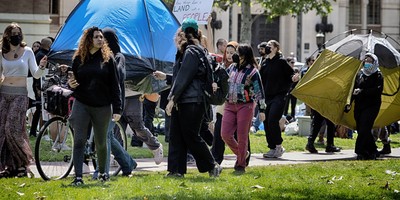The United States Capitol is one of the most dramatic buildings in Washington, D.C. It also is one of the most visited. Every spring thousands of students inaugurate tourist season in March or April, descending on the capital city to learn the fundamentals of American history, and nearly all of them visit the Capitol. Because of the increasing numbers of visitors each year, Congress in 1991 authorized funding for the planning and design of a new Capitol Visitors Center (CVC). The purported purpose of the CVC was "to make the U.S. Capitol more accessible, convenient, secure, and informative for millions of visitors each year," according to the Architect of the Capitol. When completed, the CVC will contain 580,000 square feet on three levels. The project actually is larger than the Capitol by nearly 18,000 sq. ft.
Construction on the Visitors Center began in 2001. The entire project was supposed to be finished in 2004, opening in time for the Presidential inauguration in January 2005. Construction was divided into two phases. The contract for the first phase of construction was worth $100 million. It was not finished until 2005. The second phase is now in progress, four years after the original scheduled date of completion for the entire project. The total cost for the project originally was to be about $265 million. It already is up to $554 million and counting. The new grand opening was supposed to be September 2008 but now the Government Accountability Office is reporting it may be done in November with a final cost of $621 million. Of course this does not account for further "unexpected" delays, which THE ASSOCIATED PRESS is reporting are plausible.
There also is the largely overlooked question of whether the CVC should have been built in the first place.
The National Museum of American History, one of the most popular Smithsonian Museums in Washington, D.C., is undergoing the same problem. The Museum closed September 5, 2006 for major architectural renovations. Like the CVC, it is supposed to open in September 2008 but it also is highly unlikely to open on schedule. Of course, administrators for both projects would like to see them finished in time for the inauguration in January 2009 because so many people will be in town and the Museum of American History would be able to rent out space for some of the high-profile festivities. But staff at the Museum say even a January deadline may be difficult to meet. If the renovation lasts months or years beyond the scheduled date of completion there is a high probability that the price tag will rise beyond the $45 million already allocated.
Recommended
The cost of such projects, particularly the CVC, is incredible, as is the ineptitude of Federal construction contracts. New apartment and office buildings are going up all over D.C. and most are finished in a matter of months. Yet it has taken the Federal Government seven years and counting to build the CVC. It also is more than $350 million over budget. No private company could afford such an outrageous expense. Because politicians and bureaucrats are able to allocate other people's money with few restrictions or a sense of accountability, keeping costs to a minimum and ensuring that projects finish on time is not a priority.
American taxpayers should be aware of the CVC and what it has cost them. Unfortunately, too few outside of Washington, D.C. have noticed. Consequently, the demand for a better funding system and some accountability has been kept to a minimum. The problem is, if one or two projects cost so much, how much more can we expect Congress to waste on future projects?
























Join the conversation as a VIP Member